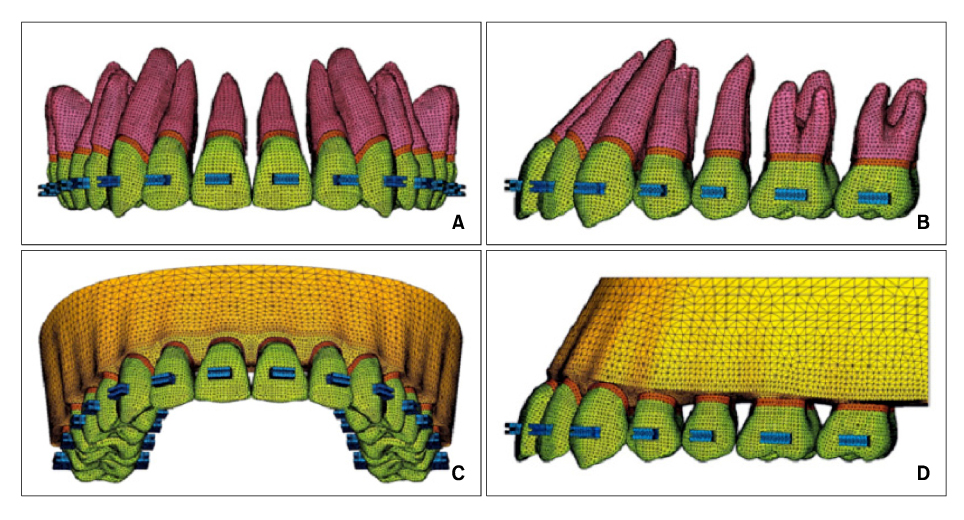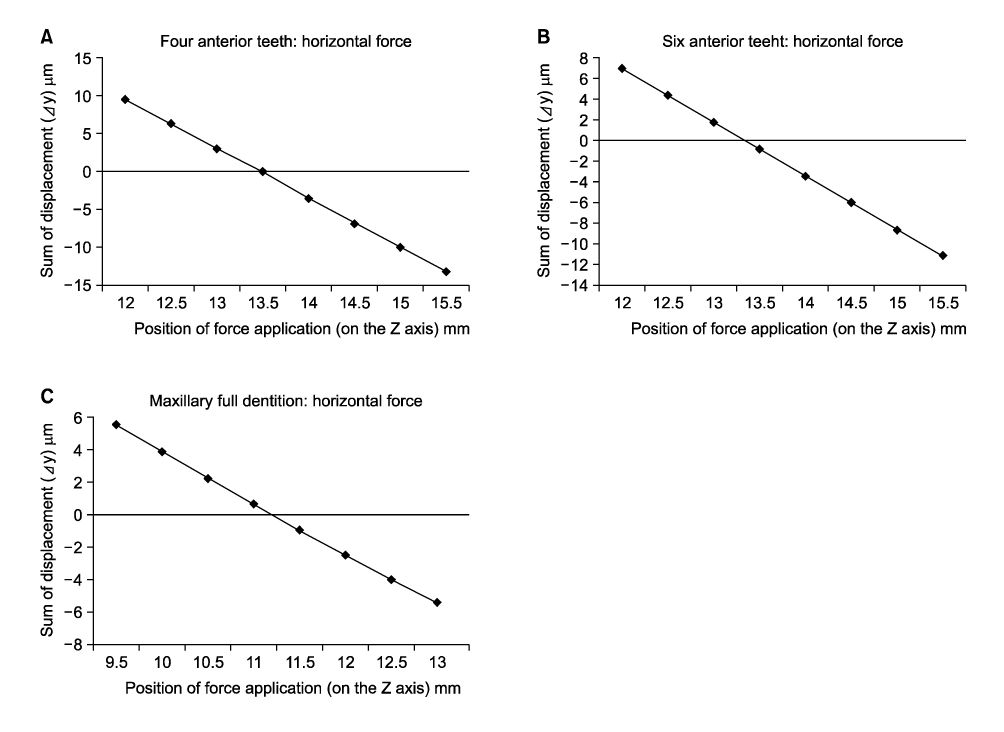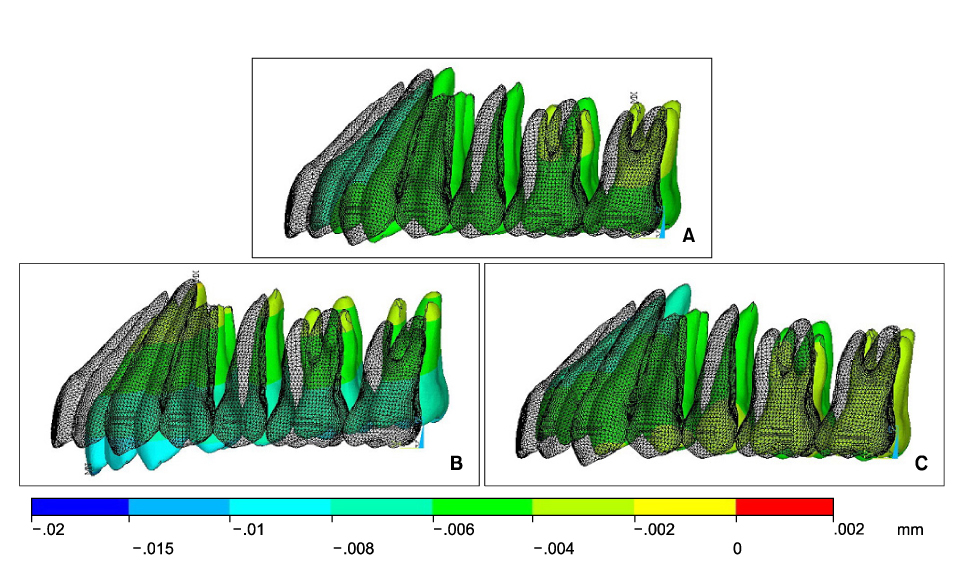Finite-element investigation of the center of resistance of the maxillary dentition
- Affiliations
-
- 1Graduate School of Clinical Dental Science, The Catholic University of Korea, Korea.
- 2Department of Orthodontics, University of Ulsan, Asan Medical Center, Korea.
- 3Department of Orthodontics, Yonsei University College of Dentistry, Korea.
- 4Department of Orthodontics, Ehwa Womans University Mokdong Hospital, Korea.
- 5Department of Orthodontics, The Catholic University of Korea, St. Mary's Hospital, Korea. dmoss1@hanmail.net
- KMID: 1975813
- DOI: http://doi.org/10.4041/kjod.2009.39.2.83
Abstract
OBJECTIVE
The aim of this study was to investigate the 3-dimensional position of the center of resistance of the 4 maxillary anterior teeth, 6 maxillary anterior teeth, and the full maxillary dentition using 3-dimensional finite element analysis. METHODS: Finite element models included the whole upper dentition, periodontal ligament, and alveolar bone. The crowns of the teeth in each group were fixed with buccal and lingual arch wires and lingual splint wires to minimize individual tooth movement and to evenly disperse the forces to the teeth. A force of 100 g or 200 g was applied to the wire beam extended from the incisal edge of the upper central incisor, and displacement of teeth was evaluated. The center of resistance was defined as the point where the applied force induced parallel movement. RESULTS: The results of study showed that the center of resistance of the 4 maxillary anterior teeth group, the 6 maxillary anterior teeth group, and the full maxillary dentition group were at 13.5 mm apical and 12.0 mm posterior, 13.5 mm apical and 14.0 mm posterior, and 11.0 mm apical and 26.5 mm posterior to the incisal edge of the upper central incisor, respectively. CONCLUSIONS: It is thought that the results from this finite element models will improve the efficiency of orthodontic treatment.
Keyword
MeSH Terms
Figure
Cited by 12 articles
-
Finite-element analysis of the shift in center of resistance of the maxillary dentition in relation to alveolar bone loss
Sang-Jin Sung, In-Tai Kim, Yoon-Ah Kook, Youn-Sic Chun, Seong-Hun Kim, Sung-Seo Mo
Korean J Orthod. 2009;39(5):278-288. doi: 10.4041/kjod.2009.39.5.278.Treatment of skeletal Class II adult patient with vertical and transverse problems caused by nasal airway obstruction using microimplant anchorage
Jong-Moon Chae, Na-Young Chang, Jin-Hyoung Cho, Kyung-Hwa Kang, Sang-Cheol Kim
Korean J Orthod. 2009;39(4):257-272. doi: 10.4041/kjod.2009.39.4.257.Finite element analysis of effectiveness of lever arm in lingual sliding mechanics
Kyeong-Hee Kim, Kee-Joon Lee, Jung-Yul Cha, Young-Chel Park
Korean J Orthod. 2011;41(5):324-336. doi: 10.4041/kjod.2011.41.5.324.3-D FEA on the intrusion of mandibular anterior segment using orthodontic miniscrews
Hyun-Kyung Park, Eui-Hyang Sung, Young-Soo Cho, Sung-Seo Mo, Youn-Sic Chun, Kee-Joon Lee
Korean J Orthod. 2011;41(6):384-398. doi: 10.4041/kjod.2011.41.6.384.Torque control during lingual anterior retraction without posterior appliances
Sung-Seo Mo, Seong-Hun Kim, Sang-Jin Sung, Kyu-Rhim Chung, Yun-Sic Chun, Yoon-Ah Kook, Gerald Nelson
Korean J Orthod. 2013;43(1):3-14. doi: 10.4041/kjod.2013.43.1.3.Distalization pattern of whole maxillary dentition according to force application points
Eui-Hyang Sung, Sung-Jin Kim, Youn-Sic Chun, Young-Chel Park, Hyung-Seog Yu, Kee-Joon Lee
Korean J Orthod. 2015;45(1):20-28. doi: 10.4041/kjod.2015.45.1.20.Displacement pattern of the anterior segment using antero-posterior lingual retractor combined with a palatal plate
Kyung-Won Seo, Soon-Yong Kwon, Kyung A Kim, Ki-Ho Park, Seong-Hun Kim, Hyo-Won Ahn, Gerald Nelson
Korean J Orthod. 2015;45(6):289-298. doi: 10.4041/kjod.2015.45.6.289.Finite element analysis of maxillary incisor displacement during en-masse retraction according to orthodontic mini-implant position
Jae-Won Song, Joong-Ki Lim, Kee-Joon Lee, Sang-Jin Sung, Youn-Sic Chun, Sung-Seo Mo
Korean J Orthod. 2016;46(4):242-252. doi: 10.4041/kjod.2016.46.4.242.A three-dimensional finite element analysis of molar distalization with a palatal plate, pendulum, and headgear according to molar eruption stage
Ju-Man Kang, Jae Hyun Park, Mohamed Bayome, Moonbee Oh, Chong Ook Park, Yoon-Ah Kook, Sung-Seo Mo
Korean J Orthod. 2016;46(5):290-300. doi: 10.4041/kjod.2016.46.5.290.Finite-element analysis of the center of resistance of the mandibular dentition
A-Ra Jo, Sung-Seo Mo, Kee-Joon Lee, Sang-Jin Sung, Youn-Sic Chun
Korean J Orthod. 2017;47(1):21-30. doi: 10.4041/kjod.2017.47.1.21.Total intrusion and distalization of the maxillary arch to improve smile esthetics
Eui Seon Baek, Soonshin Hwang, Kyung-Ho Kim, Chooryung J. Chung
Korean J Orthod. 2017;47(1):59-73. doi: 10.4041/kjod.2017.47.1.59.Three dimensional finite element analysis of continuous and segmented arches with use of orthodontic miniscrews
Eon-Hwa Lee, Hyung-Seog Yu, Kee-Joon Lee, Young-Chel Park
Korean J Orthod. 2011;41(4):237-254. doi: 10.4041/kjod.2011.41.4.237.
Reference
-
1. Lee HA, Park YC. Treatment and posttreatment changes following intrusion of maxillary posterior teeth with miniscrew implants for open bite correction. Korean J Orthod. 2008. 38:31–40.
Article2. Kim SJ, Chun YS, Jung SH, Park SH. Three dimensional analysis of tooth movement using different types of maxillary molar distalization appliances. Korean J Orthod. 2008. 38:376–387.
Article3. Smith RJ, Burstone CJ. Mechanics of tooth movement. Am J Orthod. 1984. 85:294–307.
Article4. Reimann S, Keilig L, Jäger A, Bourauel C. Biomechanical finite-element investigation of the position of the centre of resistance of the upper incisors. Eur J Orthod. 2007. 29:219–224.
Article5. Lee HK, Chung KR. The vertical location of the center of resistance for maxillary six anterior teeth during retraction using three dimensional finite element analysis. Korean J Orthod. 2001. 31:425–438.6. Pedersen E, Isidor F, Gjessing P, Andersen K. Location of centres of resistance for maxillary anterior teeth measured on human autopsy material. Eur J Orthod. 1991. 13:452–458.
Article7. Choy K, Kim KH, Burstone CJ. Initial changes of centres of rotation of the anterior segment in response to horizontal forces. Eur J Orthod. 2006. 28:471–474.
Article8. Billiet T, de Pauw G, Dermaut L. Location of the centre of resistance of the upper dentition and the nasomaxillary complex. An experimental study. Eur J Orthod. 2001. 23:263–273.
Article9. Woo JY, Park YC. Experimental study of the vertical location of the centers of resistance for maxillary anterior teeth during retraction using the laser reflection technique. Korean J Orthod. 1993. 23:375–390.10. Park GH, Shon BW. The center of resistance of the maxillary anterior segment in the horizontal plane during intrusion by using laser reflection technique. Korean J Orthod. 1993. 23:619–632.11. Vanden Bulcke MM, Burstone CJ, Sachdeva RC, Dermaut LR. Location of the center of resistance for anterior teeth during retraction using the laser reflection technique. Am J Orthod Dentofac Orthop. 1987. 91:375–384.
Article12. Matsui S, Caputo AA, Chaconas SJ, Kiyomura H. Center of resistance of anterior arch segment. Am J Orthod Dentofacial Orthop. 2000. 118:171–178.
Article13. Coolidge E. The thickness of the human periodontal membrane. J Am Dent Assoc. 1937. 24:1260–1267.
Article14. Kronfeld R. Histologic study of the influence of function on the human periodontal membrane. J Am Dent Assoc. 1931. 18:1942.15. Block PL. Restorative margins and periodontal health: a new look at an old perspective. J Prosthet Dent. 1987. 57:683–689.
Article16. Tanne K, Sakuda M, Burstone CJ. Three-dimensional finite element analysis for stress in the periodontal tissue by orthodontic forces. Am J Orthod Dentofacial Orthop. 1987. 92:499–505.
Article17. Jeong HS, Moon YS, Cho YS, Lim SM, Sung SJ. Factors influencing the axes of anterior teeth during SWA en masse sliding retraction with orthodontic mini-implant anchorage: a finite element study. Korean J Orthod. 2006. 36:339–348.18. Chung AJ, Cho JH, Kim SC, Kim US, Lee SH, Kang SS, et al. The pattern of movement and stress distribution during retraction of maxillary incisors using a 3-D finite element method. Korean J Orthod. 2007. 37:98–113.19. Zeigler A, Keilig L, Kawarizadeh A, Jäger A, Bourauel C. Numerical simulation of the biomechanical behaviour of multi-root teeth. Eur J Orthod. 2005. 27:333–339.20. Poppe M, Bourauel C, Jäger A. Determination of the elasticity parameters of the human periodontal ligament and the location of the center of resistance of single-rooted teeth a study of autopsy specimens and their conversion into finite element models. J Orofac Orthop. 2002. 63:358–370.
Article21. Andrews Lf. Straight wire, the concept and appliance. 1989. L.A.: Wells Co..22. Germane N, Bentley BE Jr, Isaacson RJ. Three biologic variables modifying faciolingual tooth angulation by straight-wire appliannces. Am J Orthod Dentofac Orthop. 1989. 96:312–319.
Article23. Park CK, Yang WS. A three-dimentional finite element analysis on the location of center of resistance during intrusion of upper anterior teeth. Korean J Orthod. 1997. 27:259–272.24. Chung KR, Oh MY, Ko SJ. Corticotomy-assisted orthodontics. J Clin Orthod. 2001. 35:331–339.25. Sugawara J, Daimaruya T, Umemori M, Nagasaka H, Takahashi I, Kawamura H, Mitani H. Distal movement of mandibular molars in adult patients with the skeletal anchorage system. Am J Orthod Dentofacial Orthop. 2004. 125:130–138.
Article26. Park YC, Lee SY, Kim DH, Lee SH. Intrusion of posterior teeth using mini-screw implants. Am J Orthod Dentofacial Orthop. 2003. 123:690–694.
Article27. Chung KR, Kook YA, Kim SH, Mo SS, Jung JA. Class II malocclusion treatment by combining a lingual retractor and a palatal plate. Am J Orthod Dentofac Orthop. 2008. 133:112–123.
Article28. Chung KR, Kim SH, Kook YA. The C-orthodontic Micro-implant. J Clin Orthod. 2004. 38:478–486.29. Min YG, Hwang CJ. A study about the change of locations of the center of resistance according to the decrease of alveolar bone heights and root lengths during anterior teeth retraction using the laser reflection technique. Korean J Orthod. 1998. 29:165–181.30. Dykman JFP. Distribution of forces in orthodontic treatment. 1969. Nijmegan, HTe Netherlands: University of Nijmegam;[Thesis].31. Türk T, Elekdag-Türk S, Dinçer M. Clinical evaluation of the centre of resistance of the upper incisors during retraction. Eur J Orthod. 2005. 27:196–201.
Article32. Lee HK, Chung KR. The vertical location of the center of resistance for maxillary six anterior theeth during retraction using three dimentional finite element analysis. Korean J Orthod. 2001. 31:425–438.33. Bourauel C, Keilig L, Rahimi A, Reimann S, Ziegler A, Jäger A. Computer-aided analysis of the biomechanics of tooth movements. Int J Comput Dent. 2007. 10:25–40.
- Full Text Links
- Actions
-
Cited
- CITED
-
- Close
- Share
- Similar articles
-
- A finite element analysis of the center of resistance of a maxillary first molar
- Finite-element analysis of the shift in center of resistance of the maxillary dentition in relation to alveolar bone loss
- The vertical location of the center of resistance for maxillary six anterior teeth during retraction using three dimensional finite element analysis
- Finite-element analysis of the center of resistance of the mandibular dentition
- Three dimensional finite element analysis of the phenomenon during distal en masse movement of the maxillary dentition










